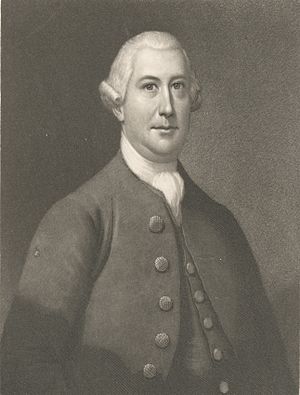James Habersham facts for kids
Quick facts for kids
James Habersham
|
|
|---|---|
 |
|
| Born | 26 January 1712 |
| Died | 28 August 1775 (aged 63) |
| Occupation | Merchant, planter, missionary, teacher politician |
James Habersham (born January 26, 1712 – died August 28, 1775) was an important person in the early history of Georgia. He was born in England but spent most of his life in the Province of Georgia.
Habersham was a merchant, meaning he bought and sold goods. He also owned large farms called plantations. He was a missionary and teacher, sharing his religious beliefs and educating others. Later, he became a politician, holding important government jobs. He helped start the first direct trade route between Savannah, Georgia, and London.
James Habersham believed that using enslaved people was good for the economy. He was a strong supporter of slavery in the Thirteen Colonies. He served as the Secretary of Georgia and also led a part of the government called the Upper House.
Even though his sons supported the American Revolution, James Habersham stayed loyal to the King of England. His death in 1775 meant he didn't have to see his family divided during the war.
Early Life and Education
James Habersham was born in Beverley, Yorkshire, England, on January 26, 1712. His father was an important person in the town. James was baptized in the Anglican church of St Mary's.
In 1722, when he was ten, he moved to London. There, he worked as an apprentice for a merchant. This means he learned the business of buying and selling goods. In the 1730s, Habersham became a follower of George Whitefield, a famous preacher. He converted to Methodism, a type of Christianity.
Whitefield asked Habersham to travel to the Province of Georgia in 1738. He went there as a missionary and schoolteacher. This decision changed his life. He taught at Bethesda Orphanage near Savannah, Georgia. This orphanage is the oldest charity still running in North America. In Savannah, he met and married Mary Bolton.
Building a Business
In 1744, James Habersham became a merchant. He started a business with Francis Harris. Their company traded goods between Georgia and Europe. This business was considered the first successful trading company in Georgia.
With the money from his business, Habersham bought land along rivers. He used this land to grow rice. At first, slavery was not allowed in Georgia. But after the ban was lifted, his rice fields grew into a very large plantation. This plantation was about 15,000 acres and was worked by 200 enslaved people.
His Role in Government
By the 1750s, James Habersham had become a powerful person in politics. He argued that slavery would help Georgia's economy. His arguments helped lead to the ban on slavery being lifted.
He was a senior advisor to the royal government of the colony. In 1754, King George II appointed him as the Secretary of Georgia. Starting in 1767, Habersham served as the President of the Georgia General Assembly's Upper House.
As president of the Upper House, he also acted as the Lieutenant Governor of Georgia. This happened when Governor James Wright was away in England from 1771 to 1772.
Family and Legacy
All three of James Habersham's sons became involved in the American Revolution. They supported the fight for American independence. Joseph Habersham became a strong supporter of the revolution in 1774. After July 1776, both he and his brother John joined the army fighting for America. His third son, James Jr., helped the revolution with his political skills and money.
However, James Habersham himself remained loyal to the King of England. He died on August 28, 1775, at 63 years old. He is buried in Savannah's Colonial Park Cemetery. Habersham Street in Savannah is named after him.

